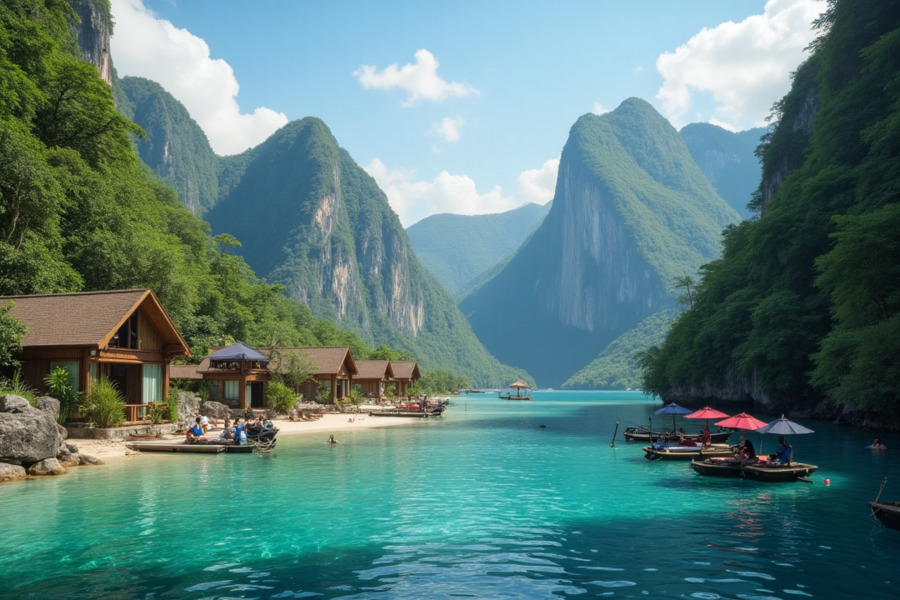≡-Brazil Celebrates a Breakthrough Whale Watching Season with Record Sightings, Early Arrivals, and Global Eco-Tourism Interest – Viral of Today
<> Viral of Today <>
Home
»
Brazil Travel News
»
Brazil Celebrates a Breakthrough Whale Watching Season with Record Sightings, Early Arrivals, and Global Eco-Tourism Interest
Wednesday, June 25, 2025
Brazil is experiencing one of its most vibrant whale seasons to date, with thousands of majestic marine mammals arriving earlier than expected along its extensive coastline. From the tropical waters of Bahia to the colder coves of Santa Catarina, the return of humpback and southern right whales in 2025 is unfolding as both a natural spectacle and a conservation milestone.
Each year, these whales journey thousands of kilometers from the freezing depths of Antarctica to the warmth of Brazilian seas—seeking safe havens to mate, give birth, and raise their calves. This ancient migratory ritual is not only a marvel of nature but also a growing driver of tourism, education, and environmental stewardship in coastal communities.
Humpbacks Take the Spotlight: Breaching into Brazilian Waters
The humpback whale (baleia jubarte) is one of the most recognizable and celebrated species in Brazilian marine life. Known for their athletic breaches, loud vocalizations, and long pectoral fins, they captivate all who see them. Once endangered, the species has made a powerful comeback, and in 2025, their numbers continue to rise.
An estimated 30,000 humpbacks are now believed to migrate along Brazil’s coastline, according to the latest aerial surveys conducted by the Instituto Baleia Jubarte. This year’s early arrivals signal a potentially record-breaking season.
Northern São Paulo Coast: Early Sightings Set the Tone
On Brazil’s southeastern coast, the cities of Ilhabela, Caraguatatuba, Ubatuba, Bertioga, and São Sebastião are experiencing a lively start to the whale season, which officially runs from May to November.
Unusually, whales were spotted as early as April 28 in São Sebastião and May 1 in Ilhabela. By June 9, more than 200 individuals had already been recorded—suggesting this season may exceed 2024’s total of 561 sightings and possibly approach the 2023 record of 786.
The Baleia à Vista Project (ProBaV) has played a key role in tracking and documenting this seasonal movement. With 718 whales cataloged to date through photo identification, their data supports conservation strategies and sustainable tourism practices across the region.
With over 120,000 tourists expected to visit during the season, the economic benefits are equally impressive. Local businesses anticipate revenues of more than R$138 million (USD 25 million) through whale tours, accommodations, and related services. Certified operators in Caraguatatuba and trained guides in Ilhabela ensure that these encounters remain both safe and respectful.
Bahia: Birthplace of Generations of Humpbacks
The northeastern state of Bahia remains the heart of the South Atlantic’s humpback breeding grounds. The area surrounding the Abrolhos Archipelago and Praia do Forte offers optimal conditions for whales to mate, calve, and care for their young.
The whale-watching season in Bahia runs from July to November, with peak activity in August and September. At Praia do Forte, the Baleia Jubarte Project hosts educational programs and boat tours, helping visitors witness these giants in a responsible and informative setting.
Arraial do Cabo: Whale Watching from the Cliffs
In Rio de Janeiro’s Lakes Region, Arraial do Cabo has earned a reputation as Brazil’s top destination for land-based whale watching. With breathtaking views from Pontal do Atalaia and Flávia Alessandra Lookout, tourists can spot humpbacks breaching just offshore—no boat required.
The 2025 whale season launched here on June 6 with a festive opening event that featured educational exhibits, guest lectures, and a 16-meter inflatable whale that let children explore marine anatomy up close.
Sightings in Arraial typically run from June to September, peaking during the southern winter months. The area is also known for dolphin activity, adding to the richness of the wildlife experience.
Santa Catarina: Safe Haven for Southern Right Whales
While humpbacks dominate the tropical and subtropical zones, southern right whales (Eubalaena australis) prefer the cooler waters of southern Brazil—particularly along the coast of Santa Catarina.
Designated as a key calving area, the southern coast sees these endangered whales return from Antarctic feeding grounds to give birth and nurse their calves. Their season normally runs from July through November, but 2025 brought early excitement: two females were spotted between May 27 and 29 near Praia do Rosa, Laguna, and Garopaba.
These whales, identified as B743 and B871, were previously recorded in 2016 and 2021 by the Franca Austral Project (ProFRANCA). In 2024, aerial surveys between Cidreira (Rio Grande do Sul) and Florianópolis (Santa Catarina) recorded 216 individuals, nearly all mother-calf pairs.
Their early return highlights the importance of increased protective measures, including regulating boat speeds and banning drone use near whale zones during critical months.
Responsible Watching: Guidelines for Whale Enthusiasts
With growing interest in whale tourism, Brazil enforces strict regulations to ensure minimal human impact:
Only book tours with certified operators authorized by environmental agencies.
Keep a safe distance: Stay at least 100 meters away from whales at all times.
Be respectful: Never chase or surround whales, and avoid loud noises near them.
Boat engines should idle, and propellers must be disengaged when whales are nearby.
Understand that sightings are not guaranteed—and that’s part of the experience.
These guidelines not only protect marine life but also ensure that future generations can continue to experience Brazil’s whale magic.
Conclusion: A Season of Celebration and Responsibility
Brazil’s 2025 whale season is more than an annual migration—it is a shared celebration of life, resilience, and environmental cooperation. From the joyful leaps of a humpback in Ilhabela to the tender moments between a mother right whale and her calf in Santa Catarina, these encounters remind us of nature’s fragility and its power.
As Brazil’s coastlines echo once more with the songs of the sea, the country reaffirms its place as a global leader in marine conservation, sustainable ecotourism, and the protection of one of Earth’s most majestic migrations.
This information will surprise you!
See also
- Read until the end to discover everything.
- Important information you need to know.
- Interesting facts and helpful tips.
Conclusion
Did you enjoy the news? Keep following us daily!













